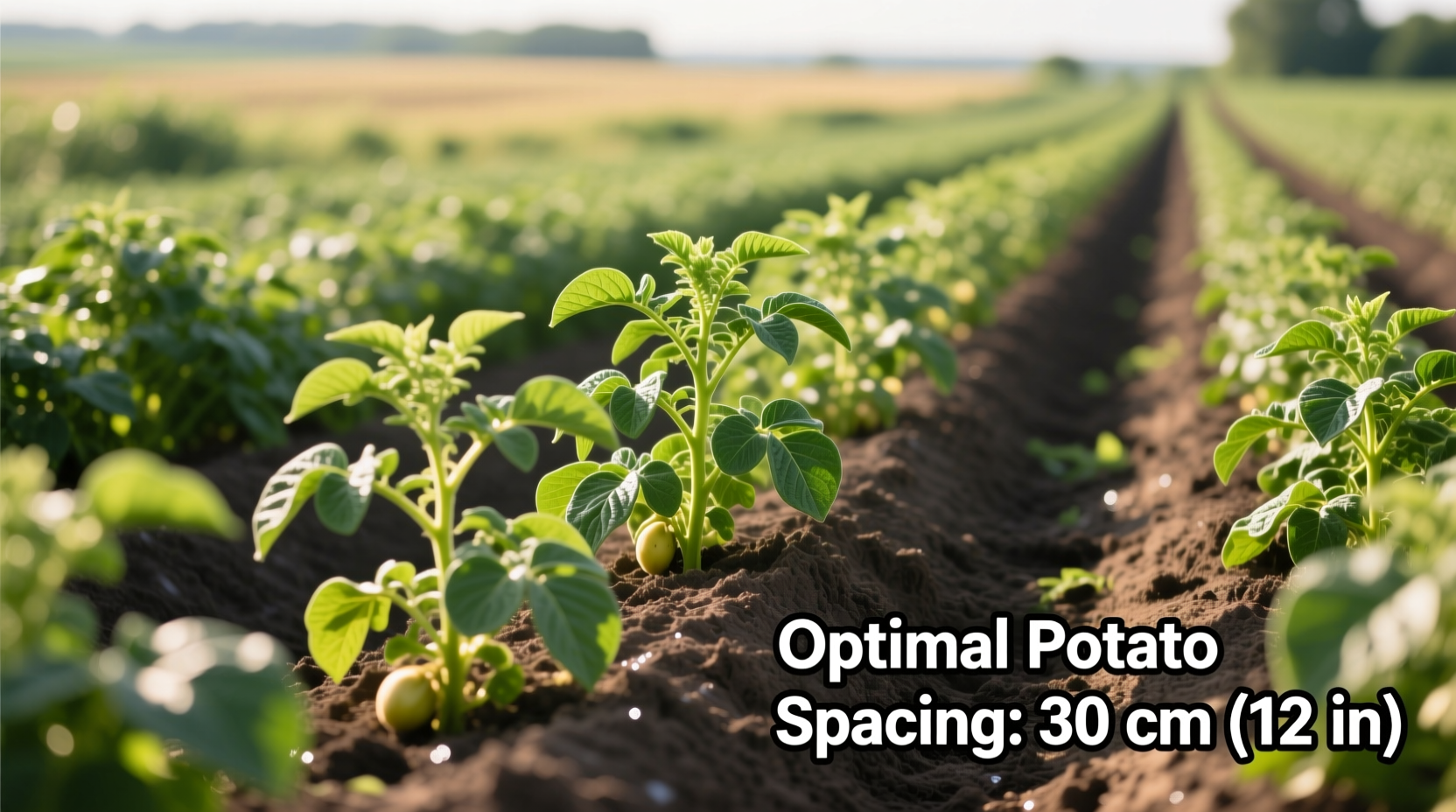Why Proper Potato Spacing Matters for Your Garden
Getting potato spacing right is one of the most critical factors determining your harvest success. When plants compete for resources, you'll end up with smaller tubers, increased disease susceptibility, and lower overall yields. Research from agricultural extensions consistently shows that properly spaced potato plants produce 25-40% more harvestable tubers than overcrowded plantings.
Your Step-by-Step Potato Spacing Guide
Follow this practical sequence to ensure your potato plants have the ideal growing conditions from planting through harvest:
1. Understanding Basic Spacing Requirements
The standard spacing recommendation works for most home garden situations. Plant seed potatoes 3-4 inches deep with the eyes facing upward. The critical measurements are:
| Spacing Element | Standard Recommendation | Adjustment for Small Spaces |
|---|---|---|
| Within-row spacing | 12-15 inches | 10-12 inches (reduced yield) |
| Between-row spacing | 24-36 inches | 18-24 inches (requires careful hilling) |
| Planting depth | 3-4 inches | Same (critical for all plantings) |
2. Adjusting Spacing for Different Potato Varieties
Not all potatoes grow the same way. Understanding your variety's growth habit helps optimize spacing:
- Russet potatoes (like Russet Burbank): Need maximum space (15 inches within rows, 36 inches between rows) as they develop extensive root systems and large tubers
- Yukon Gold and other yellow-fleshed varieties: Plant at standard spacing (12-14 inches within rows) as they produce medium-sized tubers in clusters
- Fingerling potatoes: Can be slightly closer (10-12 inches within rows) since they produce smaller individual tubers
- Red potatoes: Space at standard recommendations but monitor for overcrowding as they often produce numerous small tubers

3. Special Considerations That Affect Spacing Decisions
Your specific growing conditions may require adjustments to standard spacing recommendations:
Soil Type Matters
Heavy clay soils benefit from slightly wider spacing (add 2-3 inches) to improve drainage and reduce disease risk. In sandy soils with excellent drainage, you might reduce spacing by 1-2 inches since nutrients are more readily available.
Climate and Moisture Factors
In regions with high rainfall or irrigation, increase between-row spacing to 36 inches to improve air circulation and prevent fungal diseases. In arid climates with limited water, slightly closer spacing (24 inches between rows) can help shade the soil and reduce moisture evaporation.
Raised Bed Planting
When using raised beds, you can reduce between-row spacing to 18-24 inches since the improved soil conditions support healthier root development. However, maintain the 12-15 inch within-row spacing to prevent tuber competition.
4. Common Spacing Mistakes and How to Avoid Them
Even experienced gardeners make these spacing errors that reduce harvest quality:
Planting Too Close Together
Many gardeners try to maximize their harvest by planting potatoes too close. This leads to:
- Smaller tubers due to competition for nutrients
- Increased risk of late blight and other fungal diseases
- Difficulty hilling properly without damaging neighboring plants
- Reduced overall yield despite more plants
Inconsistent Spacing Patterns
Random or inconsistent spacing creates micro-environments where some plants thrive while others struggle. Use a measuring stick or string line to maintain consistent distances throughout your planting area.
5. The Science Behind Optimal Potato Spacing
University agricultural research provides clear evidence why proper spacing matters. According to the University of Maine Cooperative Extension, potatoes grown at 12-inch spacing produced tubers 30% larger on average than those grown at 8-inch spacing, with significantly fewer diseased specimens. Their field trials demonstrated that adequate spacing allows each plant to develop a complete root system that can access sufficient water and nutrients without competition.
The USDA Agricultural Research Service has documented how proper spacing reduces the transmission of soil-borne diseases like verticillium wilt. When plants have adequate space, air circulation improves dramatically, reducing the humidity around foliage that promotes fungal growth. Their studies show disease incidence drops by up to 60% when proper spacing guidelines are followed consistently.
6. Measuring and Marking for Perfect Spacing
Follow these practical steps for precise spacing every time:
- Prepare your soil by removing rocks and breaking up clumps
- Use a garden hoe to create straight planting trenches 4 inches deep
- Place a measuring stick along the trench edge
- Mark planting spots every 12-15 inches with a small stick or spray paint
- Drop seed potatoes into marked spots with eyes facing up
- Cover with 3-4 inches of soil and water gently
- When plants reach 6-8 inches tall, hill soil around base while maintaining row spacing
7. Troubleshooting Spacing Issues After Planting
If you notice problems after planting, these adjustments can help:
Overcrowded Plants
If you accidentally planted too close together, thin plants when they're 4-6 inches tall by carefully removing every other plant. The thinned plants can be used as potato greens in salads. This gives remaining plants adequate space to develop properly.
Poor Air Circulation Signs
If you notice yellowing leaves or early signs of fungal growth, gently prune lower leaves to improve airflow. Consider adding a light layer of straw mulch between plants to reduce soil splash while maintaining space between foliage.
Final Spacing Tips for Maximum Potato Harvest
Remember that proper potato spacing isn't just about measurements—it's about creating the optimal growing environment for your specific conditions. Monitor your plants throughout the season and be prepared to adjust your hilling technique based on how plants are developing. The investment of time in proper spacing pays off with healthier plants, easier maintenance, and a significantly better harvest at the end of the season.











 浙公网安备
33010002000092号
浙公网安备
33010002000092号 浙B2-20120091-4
浙B2-20120091-4